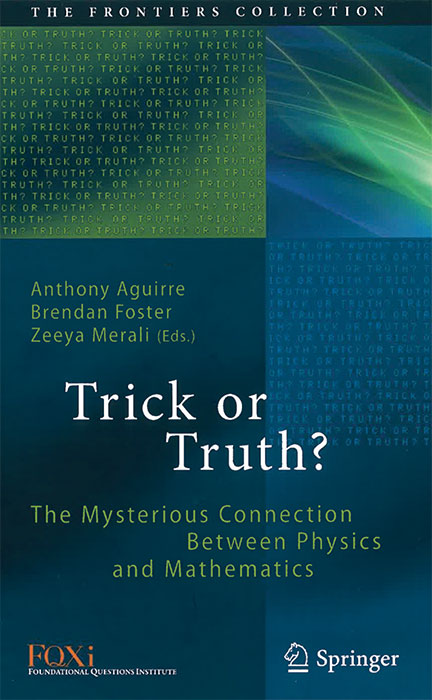By Anthony Aguirre, Brendan Foster, Zeeya Merali (eds)
Springer

One of the most intriguing works in the philosophy of science is Wigner’s 1960 paper titled “The Unreasonable Effectiveness of Mathematics in the Natural Sciences”. Indeed the fact that so many natural laws can be formulated in this language, not to mention that some of these represent the most precise knowledge we have about our world, is a stunning mystery.
A related question is whether mathematics, which has largely developed overlapping or in parallel with physics, is constructed by the human mind or “discovered”. This question is worth asking again today, when modern theories of fundamental physics and contemporary mathematics have reached levels of abstraction that are unimaginable from the perspective of just 100 years ago.
This book is a collection of essays discussing the connection between physics and mathematics. They are written by the winners of the 2015 Foundational Questions Institute contest, which invited contributors – from professional researchers to members of the public – to propose an essay on the topic.
Since it appears primarily as a subject of the philosophy of science rather than of science itself, it is not a surprise that there are conflicting viewpoints that sometimes reach opposite conclusions.
A significant point of view is that the claimed effectiveness of mathematics is actually not that surprising. This is because we process information and generate knowledge about our world in an inadvertently biased way, namely as a result of the evolution of our mind in a specific physical world. For example, concepts of elementary geometry (such as straight lines, parabolas, etc) and the mechanics of classical physics are deeply imprinted in the human brain as evolutionary bias. In a fuzzy, chaotic world, such naive mathematical notions might not have developed, as they wouldn’t represent a good approximation to that world. In fact, in a drastically unstructured world it would have been less likely that life had evolved in the first place, so it may not seem such a surprise that we find ourselves in a world largely governed by relatively simple geometrical structures.
What remains miraculous, on the other hand, is the effectiveness of mathematics in the microscopic realm of quantum mechanics: it is not obvious how the mathematical notions on which it is based could be explained in terms of evolutionary bias. Actually, much of the progress of fundamental physics during the last 100 years or so crucially depended on abandoning the intuition of everyday common sense, in favour of abstract mathematical principles.
Another aspect is selection bias, in that failures of the mathematical description of certain phenomena tend simply to be ignored. A prime example is human consciousness – undoubtedly a real-world phenomenon – for which it is not at all clear whether its structure can ever be mapped to mathematical concepts in a meaningful way. A quite common reductionist point of view typical of particle physicists is that, since the brain is essentially chemistry (thus physics), a mathematical underpinning is automatic. But it may be that the way such complex phenomena emerge completely obfuscates the connection to the underlying, mathematically clean microscopic physics, rendering the latter useless for any practical purpose in this regard.
This raises the issue of the structure of knowledge per se, and some essays in this book argue that it may not necessarily be hierarchical but rather scale invariant with some, or many, distinguished nodes. One may think of these as local attractors to which “arrows of deeper explanation” point. It may be that only locally near such attractors does knowledge appear hierarchical, so that, for example, our mathematical description of fundamental physics is meaningful only near one particular such node. There might be other local attractors that are decoupled from our mathematical modelling, with no obvious chains of explanation linking them.
On a different tack, a vehemently dissimilar and extreme point of view is taken by adepts of Tegmark’s mathematical universe hypothesis, which has been directly addressed by various authors. This posits that there is actually no difference between mathematics and the physical world, so the role of mathematics in our physical world appears as a tautology.
Surveying all the thoughts in this collection of essays would be beyond the scope of this review. Suffice it to say that the book should be of great interest to anybody pondering the meaning of physical theories, although it appears more useful for scientists rather than for the general public. It is not an easy read, but the reader is rewarded with a great deal of food for thought.







